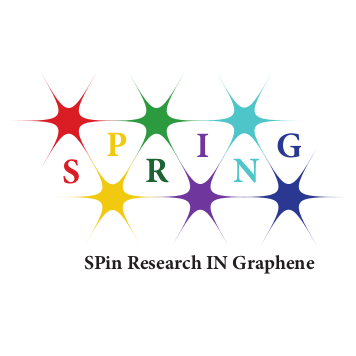SPRING - SPin Research IN Graphene

The EU-funded H2020 project SPRING (project ID 863098) is focused on the development of new graphene-based magnetic components that contribute to the creation of faster and environmentally friendly electronic devices. This international research project is coordinated by CIC nanoGUNE (ES) in partnership with IBM (CH), University of Santiago de Compostela (ES), Technical University of Delft (NL) and University of Oxford (UK), and Donostia International Physics Center (ES).
Objective
Future Information Technology will take advantage of quantum materials for efficient information processing and communication. In SPRING, we propose to utilize custom-crafted graphene nanostructures as elementary active components of a new generation of nanoscale quantum spintronic devices. Graphene structures can spontaneously develop intrinsic π-paramagnetism from topological frustrations of their structure. This unconventional magnetism is mobile, long-ranged and can be electrically addressable.
The targeted long-term vision is the development of an all-graphene platform, where spins can be used for transporting, storing and processing information. This new technology paradigm will combine fast electron mobility with electrically addressable quantum spins, in a customizable semiconducting platform, envisioning clear impact on scientific, technological and societal stakeholders.
To advance towards this goal, the interdisciplinary project SPRING combines research in physics, chemistry and engineering to fabricate graphene nanostructures with atomic precision, demonstrate and manipulate their electron and nuclear spin states, and test their potential as basic element in quantum spintronic devices. On-surface synthesis strategies will be utilized to create atomically precise open-shell graphene nanostructures with radical character, including frustrated magnetic states, spin-polarized bands, spin chains, and nuclear spins embedded at specific sites. We will demonstrate the emergence of π-magnetization and unveil the time and energy scales of spins in the open-shell structures through a combination of scanning probe and electron spin resonance spectroscopies, and develop novel predictive models of their quantum functionality.The potential of graphene open-shell platforms as a novel paradigm in spin-based logic devices will be tested by incorporating them into model devices and electrically addressing and manipulating spins.
Partners
- CIC nanoGUNE (Spain)
- Technische Universiteit Delft (Netherlands)
- Universidad de Santiago de Compostela (Spain)
- IBM Research GMBH (Switzerland)
- University of Oxford (United Kingdom)
- Donostia International Physics Center (Spain)
FOLLOW US
@springfetopen
- CIC nanoGUNE (Spain)
- Technische Universiteit Delft (Netherlands)
- Universidad de Santiago de Compostela (Spain)
- IBM Research GMBH (Switzerland)
- University of Oxford (United Kingdom)
- Donostia International Physics Center (Spain)
